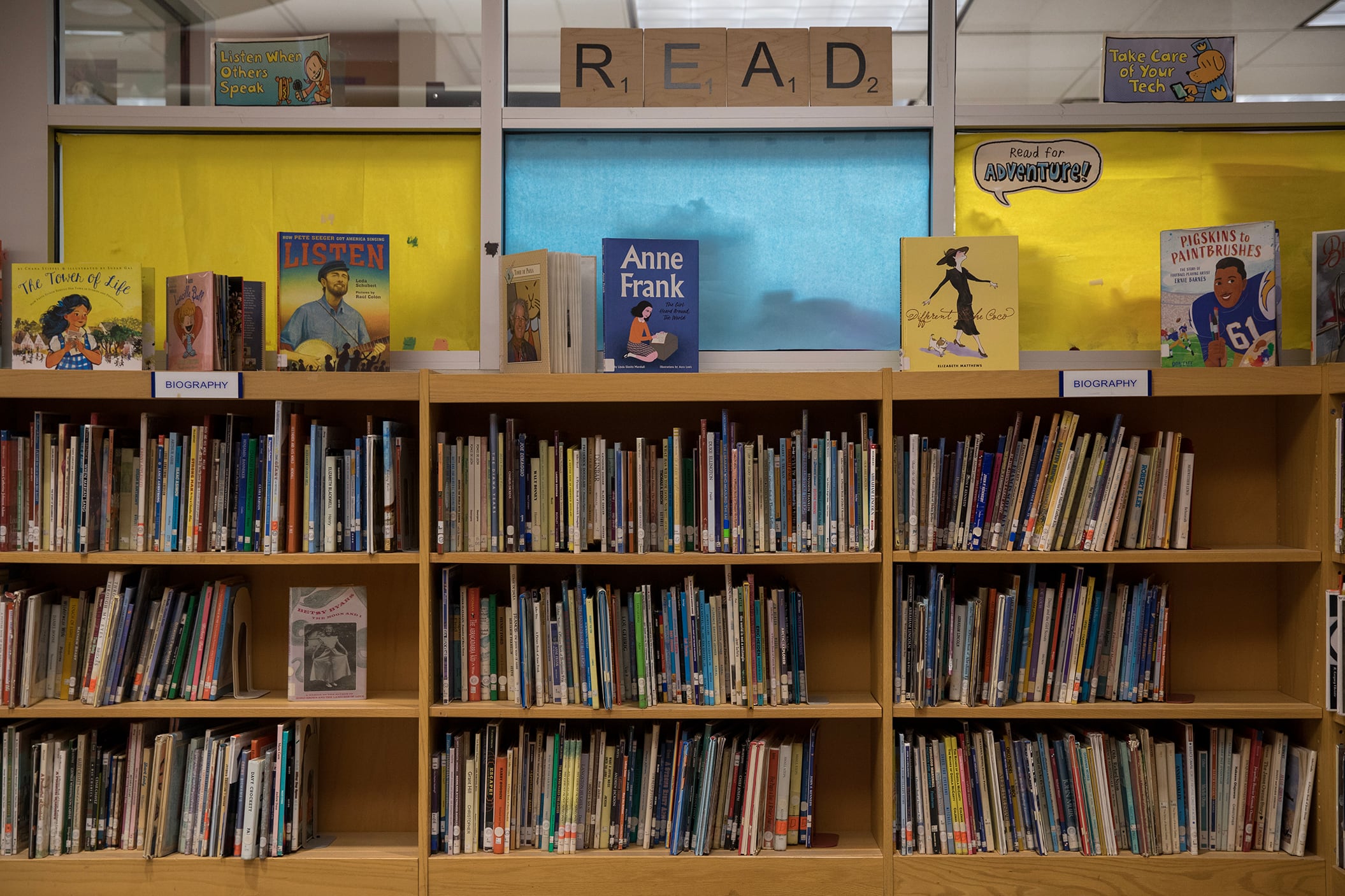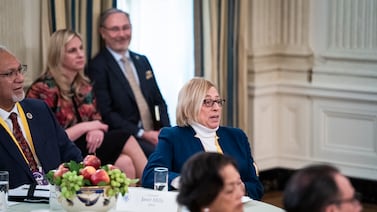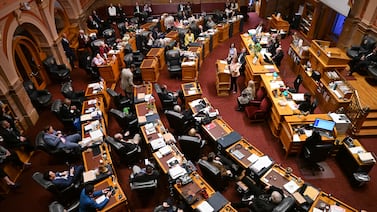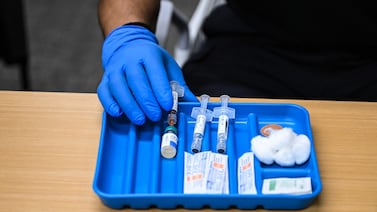Sign up for Chalkbeat’s free monthly newsletter How I Teach to get inspiration, news, and advice for — and from — educators.
Tobye Ertelt wants people to know that, contrary to popular opinion, being a school librarian is about a lot more than shelving books and reading.
At the school where she works, Oberon Middle School in Arvada, Colorado, she co-teaches history and language arts lessons, helps students learn research skills, and oversees a dozen student teaching assistants.
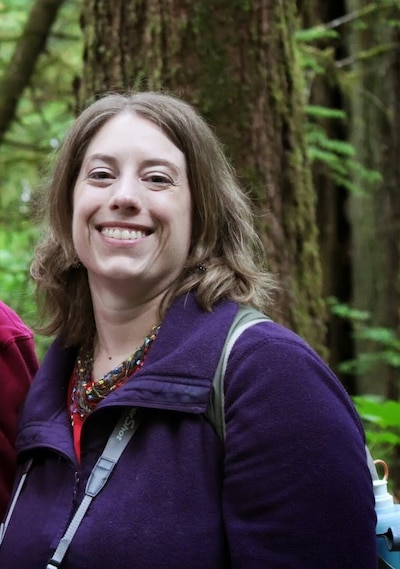
“I believe the library and the librarian are the heart and backbone of the school,” said Ertelt.
A former high school English teacher who is now a “digital teacher librarian,” Ertelt won the 2024 Distinction in School Library Services Award from the Colorado Association of Libraries.
She talked to Chalkbeat about how her murder mystery obsession inspired a lesson on research skills, how she handles library book challenges, and what she’s noticed about middle schoolers’ reading habits in recent years.
This interview has been edited for length and clarity.
Was there a moment when you decided to become a teacher librarian?
I was teaching high school English, and I was in year five of teaching. I had several administrators and other teachers suggest that I start a master’s program in curriculum development or administration. But as I was thinking about where my passion was, I realized I absolutely loved collaborating with our school librarian. I applied for a master’s program in educational technology with an emphasis on library science that December.
How did your own experience in school influence your approach to teaching?
I was a rule-follower and overachiever who took failure very hard. When I was in fifth grade, I was called to complete the math problem on the board and did it wrong. A boy in the class started laughing and making fun of me. I ran off crying. My math teacher found me a little later and told me failure wasn’t a bad thing. Failure helps us find the right path. She also told me to be confident — confident when I succeeded, and to fail confidently also.
I later found out that she had the boy in class go up to the board and asked him how he would like it if she started laughing and mocking him. That was when I started realizing that being perfect wasn’t the goal. Learning and growing was the goal. When I started teaching, I always had high standards for my students, but also made sure they understood that learning is the goal, and failure is completely OK.
Tell us about a favorite lesson to teach. Where did the idea come from?
My favorite lesson is the “Murder Mystery Research Project.” It focuses on research skills, which is hard to teach because it can be a dry subject for middle schoolers. We introduce research skills in sixth grade and dive deeper in seventh grade. We cover four main areas of information, including whether it’s from a credible and trustworthy authority, whether it contains various types of bias, what the purpose of the content is, and the date it was published. Then, we stage a “murder” in the library with three sources of evidence: the crime scene, eyewitness statements, and suspect statements. The students use their research skills to “investigate” the crime. At the end, they make accusations and give their evidence. The students are always so engaged, and it really helps bring home the importance of authority, bias, content, and date and helps them understand the importance of evaluating what they read, listen to, see, watch.
The idea came from me being a true crime junkie. I was trying to revamp my research unit, and one day while watching a true crime show, I thought, “Why can’t I use a mystery to teach research?”
School library book challenges are becoming more common. How do you approach this issue?
I’m extremely passionate about intellectual and academic freedom. Being a librarian means wanting students to love reading and have access to materials. When a book is challenged, it feels like a personal attack, but I constantly remind myself that it isn’t. That really helps me keep perspective and stay calm.
If a book is challenged, the parent or community member comes to the teacher lIbrarian first. I always explain how we vet our books according to district policy. I’ll show them there are at least two positive reviews for middle school — from publications like the School Library Journal, Kirkus Reviews, Publisher’s Weekly, or Booklist. That is what the district requires for it to be in the library.
If the challenger questions the book’s appropriateness because it goes against their values or beliefs, I listen to their objections. Then I explain that I understand their position, however, I have other families and students whose values and beliefs are different, and my role is to ensure that all values and beliefs are present in this space. I also try to emphasize that we tell students that they and their families can choose what is appropriate for them to read, but that every person is different, and we don’t choose for others.
If the issue isn’t resolved, the challenger meets with the teacher librarian and school principal. If the challenge continues, the principal contacts the community superintendent and there is a district book challenge form that needs to be completed. The district then sends it to the appropriate Book Review Committee for review, and their recommendation is sent to the superintendent.
What is the biggest misconception about the role of school librarians?
The biggest misconception is that school librarians just shelve books and read. School librarians are a robust part of school ecology. We do so much more than read books. We co-teach lessons about research, literacy, and history. Most of the time, we are also digital experts, which means we are teaching or creating lessons focused on good citizenship online.
In our district, we participate in the “Battle of the Books” competition, which encourages students to team up and read to become district champions. Many librarians run homework and tutoring programs, and help students with technology and college readiness.
How have middle schoolers’ reading habits changed over the years, especially with the growth of social media?
Interestingly, I’ve seen a growth in student reading since COVID, even with the growth of social media. I have more students who want to check out books, or who are grabbing our ebooks and audiobooks online. I’m not sure what the nationwide trend looks like, but I’ve been surprised at how many of my students check books out.
Tell us about a memorable time — good or bad — when contact with a student’s family changed your perspective or approach.
I had a student with extreme social anxiety who the counselors originally put in my class as a study hall. I soon realized she thought she was going to be one of my teacher assistants. So, I asked her to do some training with my other TAs and we transitioned her to my actual TA. I didn’t think much of it, but at parent conferences, her mother came to see me and told me that her daughter loved being a TA and that I was her favorite teacher. She told me that sometimes my class was the only reason her daughter came to school. That was an earth-moving moment for me.
All educators try to build relationships with students, but sometimes we don’t realize how small the gesture needs to be to build that connection. After this experience, I make sure to ask my TAs every day about their days, I learn their outside-of-school interests and keep up on their events. I always ask how those events went. I want students to see the library as a safe space and doing the little things is important.
What are you reading for enjoyment?
”Drop Dead Sisters” by Amelia Diane Coombs and ”Even If We Break” by Marieke Nijkamp.
Ann Schimke is a senior reporter at Chalkbeat, covering early childhood issues and early literacy. Contact Ann at aschimke@chalkbeat.org.

